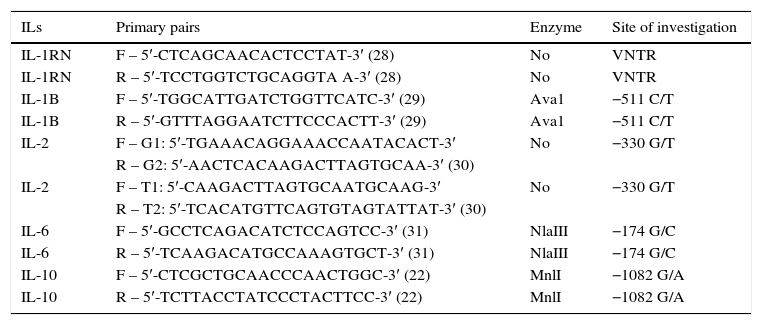This trial was designed to investigate the effects of the interleukin (IL)-1β, IL-1Ra, IL-2, IL-6, IL-10 gene polymorphisms on Behcet's disease (BD) occurrence and the association between the polymorphisms and the phenotype.
Materials and methodThe study population consisted of 71 patients and 70 age and gender-matched healthy subjects. Each of the participants had 2cc of blood withdrawn, which was placed into a whole blood tube, and the DNA was obtained using the NucleoSpin® Blood DNA Isolation kit. To display the band lengths, the products were amplified using the primary pairs of the interleukins investigated and developed in a 2% agarose gel.
ResultsThere were no significant differences between the groups with respect to the IL-1Ra, IL-1β, IL-2, IL-6 and the IL-10 gene polymorphism distributions. In the patient group the IL-1RN2 gene polymorphism was detected to be statistically correlated with the presence of articular involvement (p=0.0283) and the IL-1β gene polymorphism was statistically correlated with the presence of an ocular lesion (p=0.0178). The evaluation of the IL-2 gene polymorphism (p=0.0065) and IL-10 gene polymorphism (p=0.0483) distributions with respect to age of BD onset revealed a statistically significant distribution.
ConclusionThe statistical correlations between the articular involvement and IL-1RN, the ocular involvement and the IL-1β, and the age of disease onset and the IL-2 and IL-10 gene polymorphisms, detected for the first time in the literature, suggest that these polymorphisms could be statistically associated with the disease symptoms and used as prognostic factors.
Este estudio fue designado para investigar los efectos de los polimorfismos genéticos de interleucina (IL)-1β, IL-1Ra, IL-2, IL-6 e IL-10 en la ocurrencia de la enfermedad de Behcet (EB) y la asociación entre los polimorfismos y el fenotipo.
Materials y métodoLa población de estudio consistió en 71 pacientes y 70 sujetos sanos emparejados por edad y sexo. A cada participante se le extrajeron 2cc de sangre y el ADN se obtuvo usando el kit NucleoSpin® Blood DNA Isolation. Para mostrar las longitudes de las bandas, los productos fueron amplificados usando los primeros pares de las IL investigadas y se desarrollaron en un gel de agarosa al 2%.
ResultadosNo hubo diferencias significativas entre los grupos en relación con las distribuciones de los polimorfismos genéticos de IL-1Ra, IL-1β, IL-2, IL-6 e IL-10. En el grupo de pacientes, el polimorfismo genético de IL-1RN2 detectado se correlacionó estadísticamente con la presencia de afección articular (p=0,0283), y el polimorfismo genético de IL-1β se correlacionó estadísticamente con la presencia de lesión ocular (p=0,0178). La evaluación de la distribución del polimorfismo genético de IL-2 (p=0,0065) e IL-10 (p=0,0483) en relación con la edad de inicio de la EB reveló una distribución estadísticamente significativa.
ConclusiónLa correlación estadística entre afección articular e IL-1RN, afección ocular e IL-1β, y la edad de inicio de la enfermedad y los polimorfismos genéticos de IL-2 e IL-10, detectados por primera vez en la literatura médica, evidencian que estos polimorfismos se asociaron estadísticamente a los síntomas de la enfermedad y se podrían usar como factores pronósticos.
Artículo
Comprando el artículo el PDF del mismo podrá ser descargado
Precio 19,34 €
Comprar ahora










